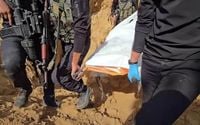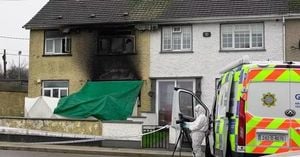On Sunday, Israel confirmed that the remains of three hostages had been returned from Gaza, marking a somber milestone as the fragile ceasefire between Israel and Hamas entered its second month. The transfer, facilitated by the International Committee of the Red Cross (ICRC), came amid ongoing efforts to recover all hostages and maintain a delicate peace in the war-torn region.
According to the Israeli military, the Red Cross took possession of three coffins containing the deceased hostages' remains in southern Gaza. These were then escorted to Israeli Defense Forces (IDF) troops in the Gaza Strip and subsequently transported to the Abu Kabir forensic institute in Tel Aviv for formal identification. The identities of the victims will be confirmed by forensic experts before being shared with their families, as emphasized by Israeli officials. The process, though routine in conflict zones, remains deeply emotional for the families awaiting closure.
Hamas, in a statement released Sunday, said the remains were found earlier that day in a tunnel in southern Gaza. The group published a photograph showing a body bag with the name of one deceased hostage, while the other two were not named. The return of these remains forms part of the ongoing ceasefire agreement, which began on October 10, 2025, and has seen a slow but steady exchange of hostages and bodies between the two sides.
Since the start of the ceasefire, Palestinian militants have released the remains of 17 hostages, with 11 still believed to remain in Gaza before this latest handover, as reported by The Associated Press. The process has been incremental, with militants releasing one or two bodies every few days. Israel, for its part, has been releasing the remains of 15 Palestinians for each Israeli hostage's body returned. However, the identification of Palestinian bodies has been hampered by a lack of DNA kits in Gaza. Health officials there report that only 75 of the 225 Palestinian bodies returned since the ceasefire began have been identified, leaving many families in limbo as they search for answers among posted photographs of the deceased.
The handover of bodies has become a focal point in the initial phase of the U.S.-brokered ceasefire plan, which includes a 20-point agreement. Central to this plan is the formation of an international stabilization force—comprising Arab and other partners—that would work alongside Egypt and Jordan to secure Gaza’s borders and ensure the ceasefire is upheld. Multiple nations have expressed interest in contributing troops to this peacekeeping force but have called for a clear United Nations Security Council mandate before committing personnel.
The return of the hostages' remains is not without its complications. Hamas has, on occasion, delivered remains that did not belong to any of the deceased hostages held in Gaza, complicating identification efforts and prolonging the anguish for families. The group claims that the widespread devastation in Gaza has made recovery efforts arduous and sometimes imprecise.
Prime Minister Benjamin Netanyahu addressed the nation on Sunday, reiterating Israel's commitment to eliminating the remaining pockets of Hamas resistance in Rafah and Khan Younis—two areas still under partial Hamas control within Israeli-held territory in Gaza. "There are actually two in Rafah and Khan Younis, and they will be eliminated," Netanyahu declared during a Cabinet meeting, as cited by The Associated Press. He further emphasized, "We will gradually bring back all our hostages. This is our commitment." Netanyahu also stressed that Israel retains full security responsibility in Gaza, dismissing claims that key decisions are being dictated by the White House. "We report to our American friends, but we do not seek their permission," he stated, making clear Israel's intent to maintain autonomy in its military operations and postwar strategy.
The ceasefire agreement, which required Hamas to return all 20 living hostages within 72 hours and all 28 deceased hostages it could locate within the same timeframe, has seen mixed compliance. While all living hostages were returned promptly, only a fraction of the deceased were handed over by the deadline. Since then, the process has inched forward, with Hamas returning additional bodies at intervals. If the latest remains are confirmed to belong to hostages, eight deceased hostages would still remain in Gaza after this handover.
The emotional toll on families has been immense. Weekly rallies in Jerusalem and other cities underscore the ongoing pain and the call for restraint. On Saturday night, Moran Harari, a friend of the late Carmel Gat, urged Israel to avoid further escalation. "This cursed war has taken so many lives of dear people on both sides of the fence. This time, we must not fall into it again," Harari said during a rally, as reported by FOX.
The broader humanitarian situation in Gaza remains dire. The deadliest and most destructive war ever fought between Israel and Hamas began with the Hamas-led attack on October 7, 2023, which killed about 1,200 people and resulted in 251 hostages being taken, according to official Israeli statements. Since then, the Israeli military offensive has killed more than 68,600 Palestinians in Gaza, according to Gaza’s Health Ministry. The ministry, which is part of the Hamas-run government and staffed by medical professionals, maintains detailed records that are generally considered reliable by independent experts, though Israel disputes the figures and has denied accusations of committing genocide in Gaza.
Amid the ongoing ceasefire, the United Nations has noted a significant decline in the looting of humanitarian aid in Gaza. UN spokesperson Stéphane Dujarric reported that only five percent of supplies were intercepted between October 10 and October 28, compared to more than 80% in the preceding months. However, accusations continue to fly: The United States Central Command (CENTCOM) recently published drone footage it claims shows suspected Hamas operatives looting an aid truck in southern Gaza. Hamas has categorically denied these allegations, calling them "false, lack[ing] field evidence, and part of a systematic disinformation campaign."
On the ground, the situation remains tense. On November 2, the Israeli military reported killing a terror operative in Gaza City who had crossed the so-called Yellow Line, posing what the military described as an immediate threat. The Israeli Air Force responded with a strike, as detailed in military statements and corroborated by Palestinian media reports.
Meanwhile, Hamas has sought to reassert control over civilian affairs in Gaza during the ceasefire. The group has regulated food prices, shutting down several shawarma restaurants accused of price gouging, and circulated lists of permitted prices on social media. These efforts, while ostensibly aimed at supporting civilians, also underscore the group’s ongoing influence and the challenges of governance amid devastation.
As the region waits for further developments, the return of the three hostages’ remains stands as a poignant reminder of the human cost of conflict and the complexity of achieving lasting peace. The painstaking process of identification and exchange continues, with families on both sides longing for closure and the international community watching closely for signs of progress—or renewed tension.




